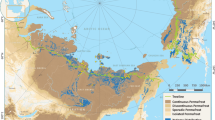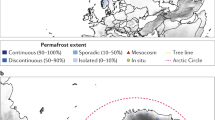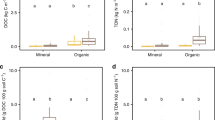Abstract
Permafrost soils contain nearly twice as much carbon as the atmosphere1. When these soils thaw, large quantities of carbon are lost, mainly in the form of methane and carbon dioxide1,2,3,4,5,6,7,8,9. In contrast, thawing is thought to have little impact on nitrous oxide emissions, which remain minimal following the summer thaw4. Here, we examined the impact of thawing on nitrous oxide production in permafrost cores collected from a heath site and a wetland site in Zackenberg, Greenland. Rates of nitrous oxide production in the heath soil were minimal, regardless of the hydrological conditions. Although rates of nitrous oxide production in the wetland soil were low following thawing, averaging 1.37 μg N h−1 kg−1, they were 18 μg N h−1 kg−1 for permafrost samples following thawing, drainage and rewetting with the original meltwater. We show that 31% of the nitrous oxide produced after thawing and rewetting a 10-cm permafrost core—equivalent to 34 mg N m−2 d−1—was released to the atmosphere; this is equivalent to daily nitrous oxide emissions from tropical forests on a mean annual basis 10. Measurements of nitrous oxide production in permafrost samples from five additional wetland sites in the high Arctic indicate that the rates of nitrous oxide production observed in the Zackenberg soils may be in the low range.
This is a preview of subscription content, access via your institution
Access options
Subscribe to this journal
Receive 12 print issues and online access
$259.00 per year
only $21.58 per issue
Buy this article
- Purchase on Springer Link
- Instant access to full article PDF
Prices may be subject to local taxes which are calculated during checkout



Similar content being viewed by others
Change history
26 May 2010
In the version of this Letter originally published, Fig. 2b was incorrect and should have been as shown here. This error has been corrected in the HTML and PDF versions of the Letter.
References
Schuur, E. A. G. et al. The effect of permafrost thaw on old carbon release and net carbon exchange from tundra. Nature 459, 556–559 (2009).
Zimov, S. A., Schuur, E. A. G. & Chapin, F. S. III, Permafrost and the global carbon budget. Science 312, 1612–1613 (2006).
Dutta, K., Schuur, E. A. G., Neff, J. C. & Zimov, S. A. Potential carbon release from permafrost soils of Northeastern Siberia. Glob. Change Biol. 12, 2336–2351 (2006).
Rodionow, A., Flessa, H., Kazansky, O. & Guggenberger, G. Organic matter composition and potential trace gas production of permafrost soils in the forest tundra in northern Siberia. Geoderma 135, 49–62 (2006).
Uhlı´řová, E., Šantrůčková, H. & Davidov, S. P. Quality and potential biodegradability of soil organic matter preserved in permafrost of Siberian tussock tundra. Soil Biol. Biochem. 39, 1978–1989 (2007).
Shur, Y. L., Hinkel, K. M. & Nelson, F. E. The transient layer: Implications for geocryology and climate-change science. Permafr. Periglac. Process. 16, 5–17 (2005).
Shur, Y. L. & Jorgenson, M. T. Patterns of permafrost formation and degradation in relation to climate and ecosystems. Permafr. Periglac. Process. 18, 7–19 (2007).
Schuur, E. A. G. et al. Vulnerability of permafrost carbon to climate change: Implications for the global carbon cycle. Bioscience 58, 701–714 (2008).
French, H. M. The Periglacial Environment 3rd edn (John Wiley, 2007).
Werner, C., Butterbach-Bahl, K., Haas, E., Hickler, T. & Kiese, R. A global inventory of N2O emissions from tropical rainforest soils using a detailed biogeochemical model. Glob. Biogeochem. Cycles 21, GB3010 (2007).
Baggs, E. M. A review of stable isotopes techniques for N2O source partitioning in soils: Recent progress, remaining challenges and future considerations. Rapid Commun. Mass Spectrom. 22, 1664–1672 (2008).
Jetten, M. S. M. The microbial nitrogen cycle. Environ. Microbiol. 10, 2903–2909 (2008).
Firestone, M. K. & Davidson, E. A. in Exchange of Trace Gases Between Terrestrial Ecosystems and the Atmosphere (eds Andreae, M. O. & Schimel, D. S.) (John Wiley, 1989).
Struwe, Yu. K., Kjøller, S. & Chen, A. Nitrous oxide production and consumption potential in an agricultural and a forest soil. Commun. Soil Sci. Plant Anal. 39, 2205–2220 (2008).
Martikainen, P. J., Nykänen, H., Crill, P. & Silvola, J. Effect of a lowered water table on nitrous oxide fluxes from northern peatlands. Nature 366, 51–53 (1993).
Bollmann, A. & Conrad, R. Influence of O2 availability on NO and N2O release by nitrification and denitrification in soils. Glob. Change Biol. 4, 387–396 (1998).
Gillam, K. M., Zebarth, B. J. & Burton, D. L. Nitrous oxide emissions from denitrification and the partitioning of gaseous losses as affected by nitrate and carbon addition and soil aeration. Can. J. Soil Sci. 88, 133–143 (2008).
Priemé, A. & Christensen, S. Natural perturbations, drying–wetting and freezing—thawing cycles, and the emission of nitrous oxide, carbon dioxide and methane from farmed organic soils. Soil Biol. Biochem. 33, 2083–2091 (2001).
Elberling, B. et al. Soil and plant community-characteristics and dynamics at Zackenberg. Adv. Ecol. Res. 40, 223–248 (2008).
Christiansen, H. H. Meteorological control on interannual spatial and temporal variations in snow cover and ground thawing in two Northeast Greenlandic circumpolar-active-layer-monitoring (CALM) sites. Permafr. Periglac. Process. 15, 155–169 (2004).
Stendel, M., Christensen, J. H. & Petersen, D. Arctic climate and climate change with a focus on Greenland. Adv. Ecol. Res. 40, 13–43 (2008).
Hansen, B. U. et al. Present-day climate at Zackenberg. Adv. Ecol. Res. 40, 111–149 (2008).
Zhang, Y., Chen, W. & Riseborough, D. W. Transient projections of permafrost distribution in Canada during the 21st century under scenarios of climate change. Glob. Planet. Change 60, 443–456 (2008).
Repo, M. E. et al. Large N2O emissions from cryoturbated peat soil in tundra. Nature Geosci. 2, 189–192 (2009).
Hasholt, B. et al. Hydrology and transport of sediment and solutes at Zackenberg. Adv. Ecol. Res. 40, 197–221 (2008).
Andersen, K., Kjær, T. & Revsbech, N. P. An oxygen insensitive microsensor for nitrous oxide. Sens. Actuat. B 81, 42–48 (2001).
Revsbech, N. P. An oxygen microelectrode with a guard cathode. Linmol. Oceanogr. 34, 474–478 (1989).
Revsbech, N. P. & Jørgensen, B. B. in Advances in Microbial Ecology Vol. 9 (ed. Marshall, K. C.) (Plenum Press, 1986).
Revsbech, N. P., Nielsen, L. P. & Ramsing, N. B. A novel microsensor for determination of apparent diffusivity in sediments. Linmol. Oceanogr. 43, 986–992 (1998).
Berg, P., Risgaard-Petersen, N. & Rysgaard, S. Interpretation of measured concentration profiles in sediment pore water. Linmol. Oceanogr. 43, 1500–1510 (1998).
Acknowledgements
This study was funded by the Norden Arctic Co-Operation Programme 2006–2008 (80142), the Norwegian Research Council (TSP Norway grant no 176033/S30), The Danish Natural Science Research Council, The University Centre in Svalbard, UNIS and the Zackenberg Research Station. Special thanks to the UNIS course AG-333 students for assisting with the permafrost coring, to L. Berg for laboratory assistance, to A. Michelsen, S. Struwe and K. Vestberg from the University of Copenhagen and L. H. Larsen from Unisense for help with analyses and advice.
Author information
Authors and Affiliations
Contributions
B.E. and H.H.C. designed and carried out the field work, permafrost modelling was done by B.U.H., and B.E. was responsible for all analysis and experiments, data interpretation and paper writing. All authors commented on the manuscript.
Corresponding author
Ethics declarations
Competing interests
The authors declare no competing financial interests.
Supplementary information
Supplementary Information
Supplementary Information (PDF 1752 kb)
Rights and permissions
About this article
Cite this article
Elberling, B., Christiansen, H. & Hansen, B. High nitrous oxide production from thawing permafrost. Nature Geosci 3, 332–335 (2010). https://doi.org/10.1038/ngeo803
Received:
Accepted:
Published:
Issue Date:
DOI: https://doi.org/10.1038/ngeo803
This article is cited by
-
Hot moment of N2O emissions in seasonally frozen peatlands
The ISME Journal (2023)
-
A globally relevant stock of soil nitrogen in the Yedoma permafrost domain
Nature Communications (2022)
-
Widespread capacity for denitrification across a boreal forest landscape
Biogeochemistry (2022)
-
Nitrous oxide emissions from permafrost-affected soils
Nature Reviews Earth & Environment (2020)
-
Carbon and nitrogen cycling in Yedoma permafrost controlled by microbial functional limitations
Nature Geoscience (2020)



